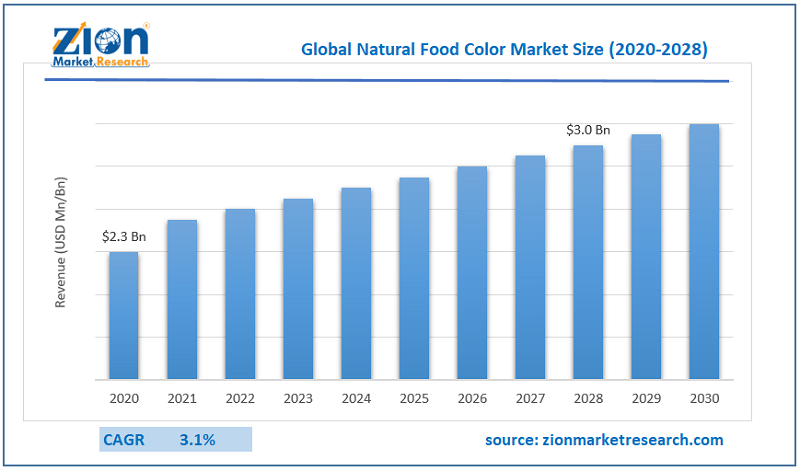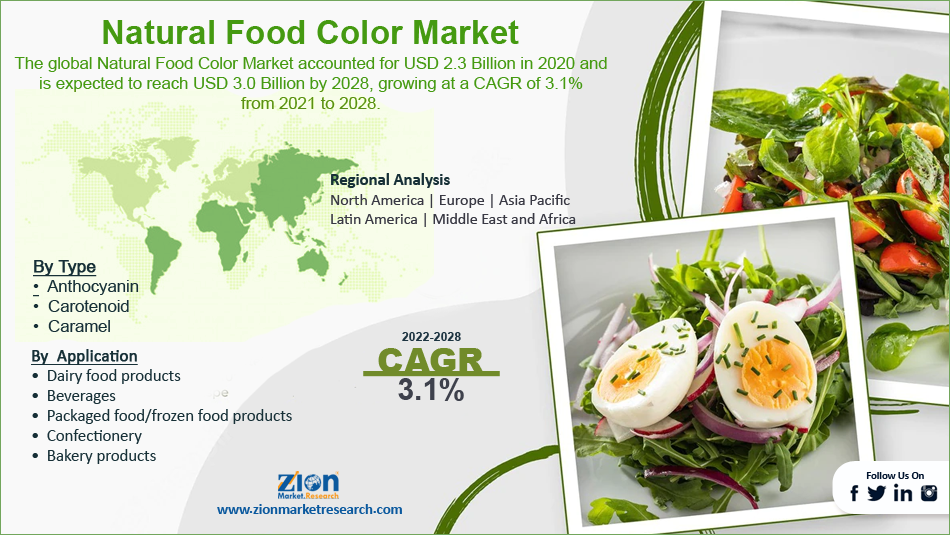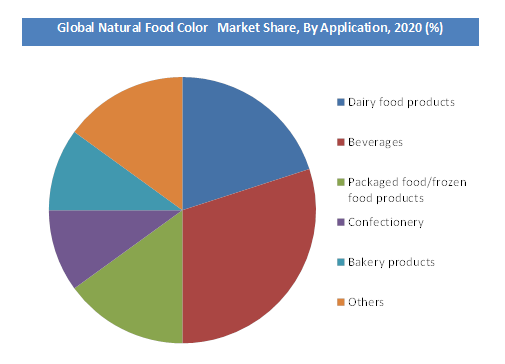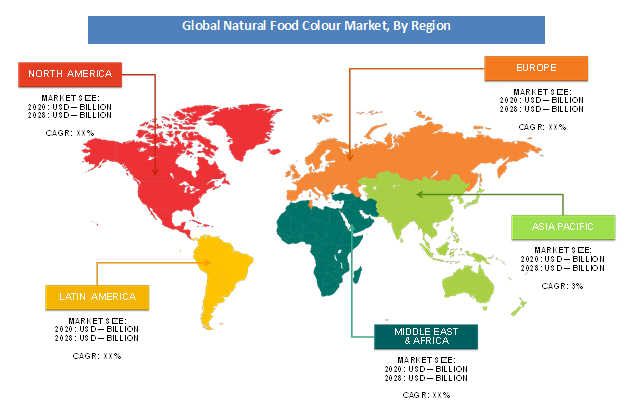Natural Food Color Market Size, Share, Trends, Growth and Forecast 2028

Natural Food Color Market By Type (Anthocyanin, Carotenoid, And Caramel), By Application (Dairy Food Products, Beverages, Packaged Food/Frozen Food Products, Confectionery, And Bakery Products): Global Industry Perspective, Comprehensive Analysis And Forecast, 2020 - 2028
| Market Size in 2020 | Market Forecast in 2028 | CAGR (in %) | Base Year |
|---|---|---|---|
| USD 2.3 Billion | USD 3.0 Billion | 3.1% | 2020 |
Natural Food Color Market: Overview
The global Natural Food Color Market Size accounted for USD 2.3 Billion in 2020 and is expected to reach USD 3.0 Billion by 2028, growing at a CAGR of 3.1% from 2021 to 2028.
The rise in demand for natural food colors within the global market is owing to rising awareness associated with the damaging effects of synthetic color employment and the chemicals utilized in making them. Prohibition in the trading of synthetic color-made goods and its predication in selected global markets like all European nations and Japan elevated the need for a natural coloring market within the last decade. This trend is probably going to hold on for years to return boosting the natural coloring market.
Nevertheless, encouragement for employing natural food colors rather than synthetic food colors in novel items like infant toys and crayons, handmade paper, and organic textile printing is probably going to unlock growth opportunities for the natural coloring market in the years to return. Additionally, to present, the high-cost making of natural coloring is one of the main limiting factors for the event of the natural coloring market.
To know more about this report, request a sample copy.
COVID-19 Impact Analysis:
The global Natural Food Color Market has witnessed a decrease in the sales for overall food and beverages products due to the lockdown enforcement placed by governments to contain COVID spreading. People had no option but to remain indoors, so the consumption of products decreased drastically. The restrictions imposed by various nations to contain COVID had stopped production resulting in disruption across the whole supply chain. However, the world markets are slowly opening to their full potential, and theirs a surge in demand for natural food colors.
Natural Food Color Market: Growth Factors
The industry is predicted to exhibit substantial growth on account of rising demand for the products by the alcoholic and non-alcoholic beverages manufacturing industries. Additionally, increasing demand for food colors obtained from non-synthetic sources including rising consumer awareness in the Asia Pacific and North America is predicted to bolster the demand over the forecast period. In addition, stringent regulations concerning the utilization of synthetic and identical colors are likely to emerge because of the major driver of industry growth.
Natural Food Color Market Report Scope:
| Report Attributes | Report Details |
|---|---|
| Report Name | Natural Food Color Market Research Report |
| Market Size in 2020 | USD 2.3 Billion |
| Market Forecast in 2028 | USD 3.0 Billion |
| Compound Annual Growth Rate | CAGR of 3.1% |
| Number of Pages | 115 |
| Forecast Units | Value (USD Billion), and Volume (Units) |
| Key Companies Covered | Sensient Technologies Corporation, Chr. Hansen Holding A/S, Symrise AG, International Flavors & Fragrances Inc., Kerry Group Plc., Givaudan SA, Royal DSM N.V., Archer Daniels Midland Company, and FMC Corporation, DD Williamson. |
| Segments Covered | By Type, By Application, And By Region |
| Regions Covered | North America, Europe, Asia Pacific (APAC), Latin America, Middle East, and Africa (MEA) |
| Countries Covered | North America: U.S and Canada Europe: Germany, Italy, Russia, U.K, Spain, France, Rest of Europe APAC: China, Australia, Japan, India, South Korea, South East Asia, Rest of Asia Pacific Latin America: Brazil, Argentina, Chile The Middle East And Africa: South Africa, GCC, Rest of MEA |
| Base Year | 2021 |
| Historical Year | 2016 to 2020 |
| Forecast Year | 2022 - 2030 |
| Customization Scope | Avail customized purchase options to meet your exact research needs. Request For Customization |
Segment Analysis Preview
The Natural Food Color Market is segmented based on types and applications where the type segments include anthocyanin, carotenoid, and caramel. Key application segments covered under this study include dairy food products, beverages, packaged food/frozen food products, confectionery, and bakery products. Carotenoids accounted for over 32% of the market revenue on account of superior usage properties such as protection against chronic diseases, anti-oxidation, and cellular damage. In addition, the growing demand for carotenoids in frozen products, non-alcoholic beverages, and bakeries is expected to aid market growth globally. Various activities carried out by market players are also expected to boost the development of the natural food color market. For example, in November 2017, Chr. Hansen expanded its series of coloring foodstuff, assisting the food & beverage makers and boosting the natural food color market.
To know more about this report, Request For Customization.
Regional Analysis Preview
Regionally, North America ruled the regional natural coloring market in 2018 due to the most important number of health-related user bases within the area paired with the need for clean & healthy label food items. The Asia Pacific is probably going to be the quickest developing division for the natural coloring market within the years to return thanks to the rising demand for natural colors for ready-to-eat food items in China and India. the center East and Latin America are likely to develop rapidly within the natural coloring market shortly.
Key Market Players & Competitive Landscape
Some of the key players in the Natural Food Color Market are
- Sensient Technologies Corporation
- Chr. Hansen Holding A/S
- Symrise AG
- International Flavors & Fragrances Inc.
- Kerry Group Plc.
- Givaudan SA
- Royal DSM N.V.
- Archer Daniels Midland Company
- and FMC Corporation
- DD Williamson.
The global natural food color market is segmented as follows:
By Type
- Anthocyanin
- Carotenoid
- Caramel
By Application
- Dairy food products
- Beverages
- Packaged food/frozen food products
- Confectionery
- Bakery products
By Region
- North America
- The U.S.
- Canada
- Europe
- France
- The UK
- Spain
- Germany
- Italy
- Rest of Europe
- Asia Pacific
- China
- Japan
- India
- South Korea
- Southeast Asia
- Rest of Asia Pacific
- Latin America
- Brazil
- Mexico
- Rest of Latin America
- Middle East & Africa
- GCC
- South Africa
- Rest of Middle East & Africa
Table Of Content
Methodology
FrequentlyAsked Questions
The global Natural Food Color Market was valued at USD 1.69 billion in 2020.
The global Natural Food Color Market is expected to reach USD 2.31 billion by 2028, growing at a CAGR of 3.9% between 2021 to 2028.
The growing demand for clean label products among consumers is expected to drive the market.
North America in 2020 ruled the Natural Food Color Market and was believed to be the highest income-generating area all over the globe.
Some of the key players in the Natural Food Color Market are Sensient Technologies Corporation, Chr. Hansen Holding A/S, Symrise AG, International Flavors & Fragrances Inc., Kerry Group Plc., Givaudan SA, Royal DSM N.V., Archer Daniels Midland Company, and FMC Corporation, DD Williamson.
Natural food colours are pigments that are derived from natural sources such as plants, fruits, vegetables, and minerals and are used to colour food products. Examples of natural food sources include: plants, fruits, vegetables, and minerals. Natural colours, as opposed to artificial colours, which are manufactured using chemicals, are thought to be safer and better for human consumption.
Choose License Type
RelatedNews
HappyClients
Zion Market Research
Tel: +1 (302) 444-0166
USA/Canada Toll Free No.+1 (855) 465-4651
3rd Floor,
Mrunal Paradise, Opp Maharaja Hotel,
Pimple Gurav, Pune 411061,
Maharashtra, India
Phone No +91 7768 006 007, +91 7768 006 008
US OFFICE NO +1 (302) 444-0166
US/CAN TOLL FREE +1 (855) 465-4651
Email: sales@zionmarketresearch.com
We have secured system to process your transaction.
Our support available to help you 24 hours a day, five days a week.
Monday - Friday: 9AM - 6PM
Saturday - Sunday: Closed









